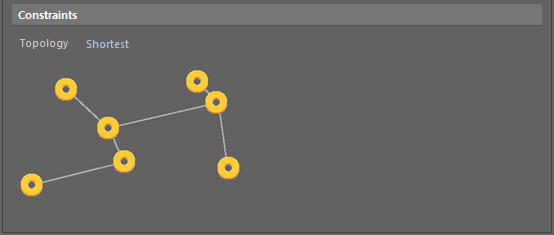Working with the Routing Topology Design Rule on a PCB in Altium NEXUS
This document is no longer available beyond version 4.0. Information can now be found here: Routing Topology Rule for version 5
Rule category: Routing
Rule classification: Unary
Summary
This rule specifies the topology to be employed when routing nets on the board. The topology of a net is the arrangement or pattern of the pin-to-pin connections. By default, pin-to-pin connections of each net are arranged to give the shortest overall connection length. A topology is applied to a net for a variety of reasons; for high speed designs where signal reflections must be minimized the net is arranged with a daisy chain topology; for ground nets a star topology could be applied to ensure that all tracks come back to a common point.
Constraints
 Default constraint for the Routing Topology rule.
Default constraint for the Routing Topology rule.
- Topology - defines the topology to be used for the net(s) targeted by the scope (full query) of the rule. The following topologies can be applied:
Shortest- this topology connects all nodes in the net to give the shortest overall connection length.Horizontal- this topology connects all the nodes together, preferring horizontal shortness to vertical shortness by a factor of 5:1. Use this method to force routing in the horizontal direction.Vertical- this topology connects all the nodes together, preferring vertical shortness to horizontal shortness by a factor of 5:1. Use this method to force routing in the vertical direction.Daisy-Simple- this topology chains all the nodes together, one after the other. The order they are chained is calculated to give the shortest overall length. If a source and terminator pad are specified, then all other pads are chained between them to give the shortest possible length. Edit a pad to set it to be a source or terminator. If multiple sources (or terminators) are specified, they are chained together at each end.Daisy-MidDriven- this topology places the source node(s) in the center of the daisy chain, divides the loads equally and chains them off either side of the source(s). Two terminators are required, one for each end. Multiple source nodes are chained together in the center. If there are not exactly two terminators theDaisy-Simpletopology is used.Daisy-Balanced- this topology divides all the loads into equal chains, the total number of chains equal to the number of terminators. These chains then connect to the source in a star pattern. Multiple source nodes are chained together.Starburst- this topology connects each node directly to the source node. If terminators are present, they are connected after each load node. Multiple source nodes are chained together, as in theDaisy-Balancedtopology.
How Duplicate Rule Contentions are Resolved
All rules are resolved by the priority setting. The system goes through the rules from highest to lowest priority and picks the first one whose scope expression matches the object(s) being checked.
Rule Application
During autorouting.
Note
When using the Autorouter, routing completion time may be longer when using topologies other than Shortest.
